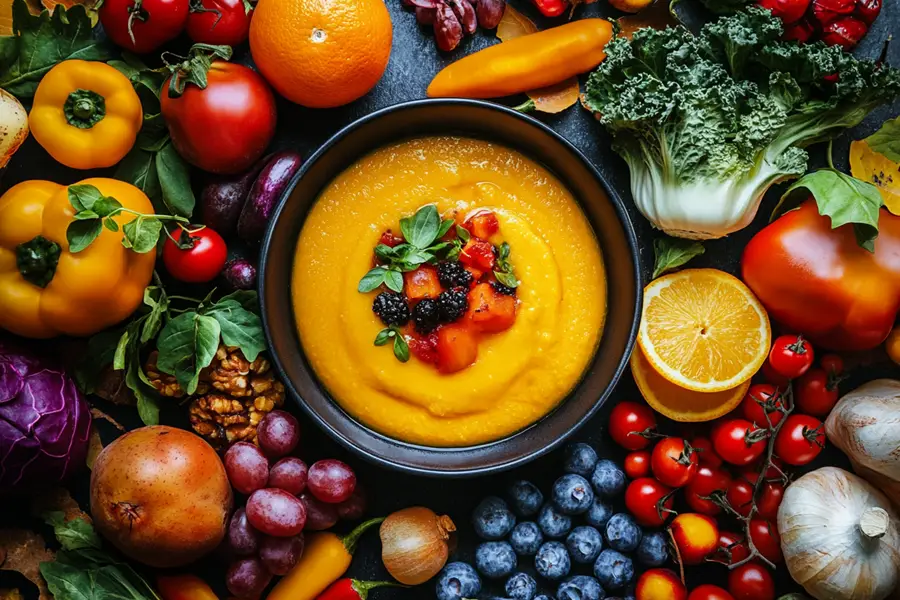Table of Contents
Introduction: The Joy of Seasonal Baking
Seasonal baking brings the magic of each season right into your kitchen. It’s not just about following the calendar—seasonal baking lets you use fresh, flavorful ingredients that are at their peak, ensuring that your baked goods taste their best all year round.
The beauty of this approach lies in its versatility:
- In the fall, we savor warm spices and hearty fruits like pumpkins and apples.
- Winter baking invites comfort and richness, using ingredients like chocolate and nuts.
- Spring introduces us to fresh fruits like strawberries and citrus, while summer calls for light, fruity desserts with berries and peaches.
Why Seasonal Baking Matters
By embracing the changing seasons, you’re not only following the rhythm of nature but also creating memorable baked goods that celebrate each season’s unique flavors.
Here are three main reasons why seasonal baking is a must:
- Freshness: Using in-season produce ensures that you get ingredients at their freshest and most flavorful, which significantly enhances the taste of your desserts.
- Cost-effectiveness: Seasonal produce is often more affordable since it’s more abundant.
- Sustainability: Choosing local and seasonal ingredients can lower your carbon footprint and promote more sustainable baking practices.
The Best Tools and Tips for Seasonal Baking
To make your seasonal baking a breeze:
- Stock up on seasonal staples: Each season has its own must-haves. For fall, consider pumpkins and pecans; for spring, think about strawberries and lemons.
- Master simple techniques: Whether you’re perfecting your pie crust or whipping up a light sponge cake, focusing on the basics can elevate your baking.
In conclusion, seasonal baking not only keeps your kitchen in tune with nature but also opens up endless opportunities for creative and flavorful desserts throughout the year. Embrace it, and you’ll never run out of inspiration for your next baking session.
Seasonal Baking for Every Time of Year
Each season brings its own flavors, textures, and baking opportunities. By adjusting your recipes to reflect the time of year, you can create delicious baked goods that highlight seasonal ingredients and the unique tastes they bring. Let’s explore how to bake through the seasons!
Fall Baking Delights
The fall season is synonymous with warm spices, hearty fruits, and comforting desserts. It’s the perfect time to incorporate ingredients like pumpkin, apples, and pecans into your baking.
- Popular Fall Ingredients:
- Pumpkin: Ideal for pies, breads, and even cookies. Pumpkin pairs perfectly with cinnamon and nutmeg.
- Apples: Crisp and juicy, apples shine in apple pies, crumbles, and cakes.
- Pecans: Add crunch to pies and cookies, especially in a classic pecan pie or a pumpkin-pecan cheesecake.
Winter Comfort Baking
Winter calls for indulgence and warmth. The cooler months are ideal for richer, denser desserts that provide comfort on cold days. Popular ingredients include chocolate, ginger, and cranberries.
- Top Winter Ingredients:
- Chocolate: Warm up with rich chocolate cakes, brownies, or chocolate bread pudding.
- Cranberries: These tart berries are a wonderful addition to muffins, cakes, and even savory cranberry bread.
- Ginger: Gingerbread cookies, ginger cakes, and other spiced treats bring the warmth of winter into your kitchen.
Spring Freshness in Baking
Spring is all about renewal, and this is reflected in the lighter, fruit-forward desserts that celebrate the fresh flavors of the season.
- Key Spring Ingredients:
- Strawberries: Perfect for shortcakes, tarts, and muffins, strawberries burst with spring flavor.
- Rhubarb: Often paired with strawberries, rhubarb adds a tart contrast in pies and crumbles.
- Lemon: Citrus brings a bright, tangy flavor to cakes, scones, and cookies.
Summer Light and Fruity Baking
Summer baking revolves around light, fruity desserts that are perfect for picnics, barbecues, and outdoor gatherings. This season celebrates the abundance of fresh berries, peaches, and herbs.
- Popular Summer Ingredients:
- Peaches: Make a peach cobbler, pie, or tart with the juiciest fruits of the season.
- Berries: Blueberries, raspberries, and blackberries are ideal for everything from berry tarts to summer galettes.
- Herbs: Herbs like lavender and basil can add surprising depth to sweet summer desserts.
Tips for Mastering Seasonal Baking
Mastering seasonal baking can elevate your kitchen skills and help you create memorable, flavor-packed treats all year round. Here are some practical tips to make the most of seasonal ingredients, ensuring that every bake turns out perfect.
1. Know What’s in Season
Understanding what fruits, vegetables, and spices are at their peak each season is crucial to creating delicious and fresh baked goods. Here’s a quick guide:
- Spring: Strawberries, rhubarb, citrus fruits
- Summer: Peaches, berries, cherries
- Fall: Apples, pumpkins, pears
- Winter: Cranberries, citrus, chestnuts
2. Adjust Baking Times for Fresh Ingredients
Fresh fruits add moisture to your baked goods, so it’s essential to adjust your baking times accordingly:
- When using berries or apples, add an extra 5-10 minutes to ensure the dessert cooks thoroughly without becoming soggy.
- For pumpkin puree, reduce liquid in your recipe by a few tablespoons to balance the added moisture.
3. Use Spices to Complement the Season
Spices play a key role in adding depth to your seasonal bakes. Here’s how to match spices with the seasons:
- Cinnamon and nutmeg for fall and winter
- Citrus zest and ginger for spring
- Lavender and basil for summer
4. Store Ingredients Properly
To make the most of your ingredients, proper storage is crucial. Seasonal fruits can often spoil quickly if not stored well. Here are some quick tips:
- Berries should be stored in the fridge and eaten within a few days.
- Pumpkins and squashes can be stored in a cool, dark place for several weeks.
5. Practice Batch Baking
When certain ingredients are in season, stock up and bake in batches! This is particularly useful for summer berries or fall apples. You can freeze these ingredients or your baked goods to enjoy later in the year.
Sustainable and Eco-Friendly Seasonal Baking
Incorporating sustainable baking practices into your kitchen not only helps protect the environment but also enhances the quality of your baked goods. By using locally sourced and seasonal ingredients, reducing waste, and choosing eco-friendly alternatives, you can make your baking routine much greener. Let’s explore how to achieve this.
1. Choose Local and Organic Ingredients
One of the simplest ways to bake sustainably is by choosing locally sourced and organic ingredients. When you buy ingredients that are in season and produced close to home, you:
- Reduce your carbon footprint by cutting down on transportation emissions.
- Support local farmers and businesses in your area.
For example, consider shopping at your local farmers’ markets or subscribing to a community-supported agriculture (CSA) program.
2. Reduce Food Waste
A significant part of eco-friendly baking involves minimizing food waste. Here are a few simple ways to achieve this:
- Plan your recipes around what’s in season: Baking with fresh, in-season produce ensures that you use up ingredients while they’re at their best.
- Repurpose leftovers: For example, leftover fruit can be turned into jams, and stale bread can be used in bread puddings.
3. Use Eco-Friendly Baking Tools and Materials
Eco-friendly baking goes beyond ingredients. Opt for reusable tools and sustainable materials:
- Silicone baking mats instead of parchment paper.
- Glass or stainless steel mixing bowls over plastic ones.
- Reusable silicone muffin liners instead of paper liners.
4. Embrace Plant-Based and Sustainable Alternatives
Using plant-based alternatives and sustainable ingredients can further reduce your environmental impact. For example:
- Replace dairy with plant-based milks, like almond or oat milk.
- Use flaxseed or chia seeds as egg substitutes in recipes.
5. Minimize Energy Consumption
To make your baking more energy-efficient:
- Bake in batches to reduce oven usage.
- Use convection ovens which use less energy and cook more efficiently.
- When possible, try no-bake desserts like raw cakes and energy bites during warmer months, cutting down energy use entirely.
FAQs About Seasonal Baking
When diving into the world of seasonal baking, several common questions arise. Below are answers to some of the most frequently asked questions, designed to help you get the most out of your seasonal ingredients and baking techniques.
1. What are the best ingredients for fall baking?
Fall is a time when rich, warm flavors dominate. The best ingredients for fall baking include:
- Pumpkins: Perfect for pies, cakes, and muffins. Try our Pumpkin Bread Recipe for a fall favorite.
- Apples: Versatile and delicious, apples shine in crisps, pies, and breads.
- Cinnamon and nutmeg: Essential spices to add warmth to your baked goods.
2. How can I make my baked goods more sustainable?
Sustainable baking is all about making eco-friendly choices in your kitchen. Here are some tips:
- Use local, seasonal ingredients: This reduces transportation emissions and supports local farmers.
- Cut down on waste: Repurpose leftovers, such as using overripe fruit for jams or sauces.
- Eco-friendly materials: Swap single-use items for reusable baking mats or silicone liners.
3. What seasonal fruit works best for spring baking?
Spring is a season full of vibrant, fresh fruits. Some of the best fruits for spring baking include:
- Strawberries: Perfect for tarts, shortcakes, and muffins.
- Rhubarb: Often paired with strawberries in pies or crumbles.
- Lemon: Adds a bright, tangy flavor to cakes and scones. Try our Lemon Cake Recipe for a spring treat.
4. What types of desserts are best for summer baking?
Summer calls for light and fruity desserts that complement warm weather. Here are some great options:
- Berry tarts: Highlight fresh berries like raspberries, blueberries, and strawberries.
- Peach cobbler: A classic summer dessert that’s easy to prepare.
- Lavender scones: Incorporate herbs for a unique flavor twist.
Conclusion: Embrace the Art of Seasonal Baking
As you’ve seen throughout this guide, seasonal baking offers endless opportunities to experiment with fresh, flavorful ingredients that reflect the bounty of each season. By focusing on what’s in season, you can create delicious desserts that not only taste better but also align with sustainable and eco-friendly practices.
Key Takeaways:
- Use fresh, local ingredients to ensure your bakes are packed with flavor and environmentally friendly. Whether you’re baking with strawberries in spring or pumpkins in fall, these seasonal ingredients bring out the best in your recipes.
- Adjust your techniques based on the season. From lighter, fruit-based desserts in the summer to heartier, spiced treats in the winter, adapting your baking approach keeps your desserts seasonally relevant and exciting.
What’s Next?
As you continue your seasonal baking journey, keep experimenting with new flavors and sustainable practices. Your kitchen will be filled with warmth, flavor, and the satisfaction of knowing you’re baking in harmony with the seasons.

